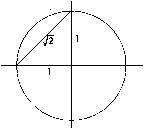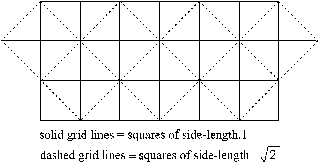Towards new ways of representing numbers (number notations)
Scale structure theory attributes the many merits of our current number-system to its interlinking and attuning of various music-like scales applying to number.... For example, in our number–system the scale of numerals (1-9) is matched to the scale of the base of our number system (10), the positional scale is matched to sequential powers of 10 i.e. units column (100), tens column (101), hundreds column (100), which is thus synchronised to the scale of integers, and these are kept aligned within appropriate columns representing incremental powers of ten via the zero as placeholder (and which also serves as a null number).
While many (including myself) have marvelled at the merits of our current positional number-system, some have seen in it complete perfection, and a story at an end.
Yet several weaknesses of the current number-system, in my view, consist in the following:
-
the one-dimensional sequence of numerals is limiting and does not codify or symbolize the factorization of numbers, other than in some simple cases, such as numbers ending in zero are divisible by ten, and numbers ending in “5” are divisible by “5”
-
the fact that the numerals themselves bear no resonant relation to the value they represent; for example “7” is an abstract sign for the quantity seven, and although the numeral is efficient in being simple and easy to write by hand, there is no logical connection between the sign and the quantity it represents
-
even though the numbers of our current notation may be arranged in rows aligned vertically (corresponding to their columnar organization), the positional number-system nevertheless reflects virtually nothing of the profound interconnection between numbers and geometries
√2 is not geometrically irrational
The lexicology of mathematics has also proven problematic as we have seen in various ways. Words like “rational” were applied to numbers that could be expressed as the ratio of two whole numbers. Then it was discovered that √2 was not a rational number (as the word “rational” had been defined). Hence were born the ‘irrational numbers’. But the point seems to have been missed that, in the geometry of Classical Greece, √2 was (and is) commensurable with the whole numbers in that you could very easily construct this so-called irrational segment length, with an unmarked straight-edge and compasses. By Pythagoras’ Theorem, √2 is simply the length of the hypotenuse of a right triangle whose two other sides are each of unitary length. I have drawn such a construction (see fig. 112),

Figure 112
with which the Greeks were well familiar, illustrating the simplicity of the geometry involved and also that, from the perspective of the geometry, √2 is a most rational number. ...the length √2 is fully commensurable and rational in that you can clearly see how the tessellation of squares is simply rotated 45 degrees° and enlarged so as to perfectly synchronize with the node points of the underlying original tessellation. This perfect synchronization of the geometric grids in hemi-orthogonal relation is a two-dimensional form of ‘ratio’ and therefore a geometrically-rational division.

Figure 113
The conclusion we may therefore draw is that the definition of a ‘rational number’ has, for more than two thousand years, rested upon an absolutist relic of a bygone era: an incumbent numerical notation that is essentially static in its morphology and of a rigid syntax (irrespective of the possibility of variation in the base used). Our number–system, for all its merits, has much room for improvement.
Another irony emerges in the ‘irrationality’ of π. Curiously, π is defined as a ratio—the circumference of a circle divided by its diameter, one finite value divided by another finite value which fits the former perfectly within Euclidean geometry—yet if expressed in terms of our number–system, is irrational, incommensurable. Something is seriously awry. The number notation is out of step with the geometry. The problem seems to be that the current number notation is rather static and inflexible. It cannot adequately reflect the dynamic inter-connectedness of the universe, let alone of geometry...
Another problem with the Fundamental Theorem of Arithmetic
The problem concerns the concept of dimensionality in number. For example, a shape has two factors ('length' x 'breadth') whereas three factors implies a three-dimensional object in geometry ('length' x 'breadth' x height'), etc.
The Fundamental Theorem of Arithmetic breaks down numbers into a string of prime factors and it seems more suited to the one-dimensional model of the number-line. The number of such prime factors varies enormously from one number to the next. This then implies numbers of enormously divergent dimensions (considered spatially) even from one number to the next in our ordinal nunber-line.
Considering all numbers as 'shapes'
This simplifies the above situation into interesting new sets of shapes to which we may more easily apply scale structure theory.
Take again our example of the random number 24, which, according to the Fundamental Theorem of Arithmetic, has a unique factorization ('fingerprint') of primes as follows: 2 x 2 x 2 x 3. Now, geometrically-speaking, we would say this has four dimensions (represented by each number in the factorization).
But let us assume for a moment that this number "24" exists only within the two-dimensional coordinate geometry of the plane. This is very interesting, because the Fundamental Theorem does have a modulated application here: in determining the different shapes (and hence side-lengths) of the set of possible shapes for this number "24" in the 2-dimensional plane*. If dealing in whole numbers only (in tune with the Fundamental Theorem of Arithmetic itself) we could have, for example a 1 x 24 triangle, a 2 x 12 triangle, a 3 x 8 triangle, or a 4 x 6 triangle†. Thus straight away, we see how moving from the traditional one-dimensional number-line in current general practice, has opened up new 'properties' or 'qualities' of number: number as shape(s).
The adoption of a base within a numerical notation (e.g. base 10) appears to be directly related to the attendant irrationality inherent in its associated 'number theory'. The binary language (base 2) of the computer is not immune either since it remains essentially founded upon a positional system of numeration—the legacy of pencil and paper. The geometric forms and interrelations of numbers, especially the simplicity and vastness of these, remains tantalizingly out of reach of our current systems of numeration and notation.
'Square plugs' have been inducted again as matrices (sometimes monstrous)—a kind of modern-day 'abacus' which, although they may 'do the job', seem to 'jar' and add an unnerving complexity to (and distance from) the resplendence and resonance of the forms of the Geometry.
A logic of symphysis and tessellation
Only certain shapes can fit together without gaps. This has implications to new new number systems which move far beyond the age-old ordinal concept of (first, second, third, etc) and point rather to a new more sophisticated 'grammar' or 'syntax' in which numbers are logically 'connected' to other numbers in completely new ways.
Proceeding from one number to the next ('in line') by the traditional ordinal method of adding one-unit-at-a-time to derive successive units is now seen as completely inadequate within the two-dimensional realm of 'number as shape'. Here, numbers interface (connect) with one another in a far more sophisticated way. Furthermore, numbers (like "24" as we have seen, are pleomorphic— they form a family of shapes, each of which represents "24" in terms of area, and even possibly in terms of other attributes.)
| back to top |
next > |